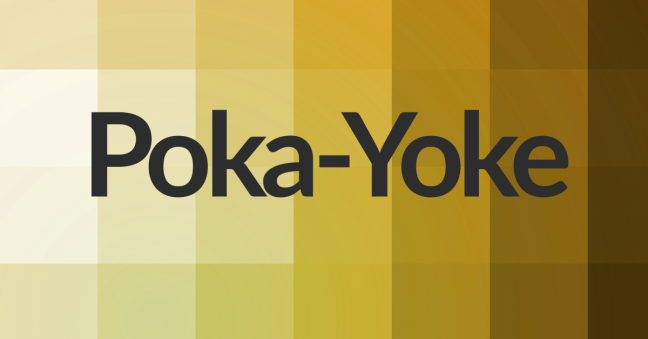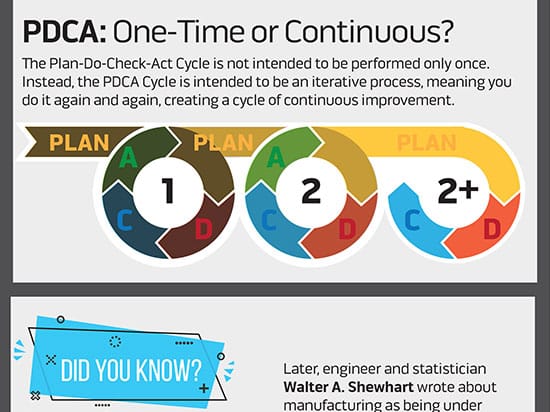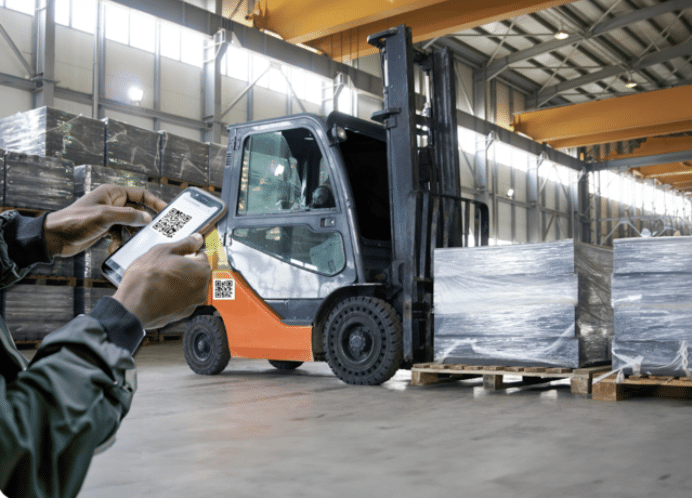April 15, 2020

What Is Poka-Yoke?
Industry:
Solution:

 One powerful idea in the lean manufacturing toolkit is poka-yoke, which can be translated into English as something like "mistake-proofing."
By designing equipment and work processes to make certain kinds of error impossible, we can reduce error, reduce waste, and improve quality and value.
Although poka-yoke is an important part of lean manufacturing, you can see that it's important outside of a lean context too. For example, safety professionals often speak of prevention through design, which is clearly a similar idea. So poke-yoka can help you improve efficiency, quality, safety, profitability and even worker morale while increasing value for the customer.
Read the rest of the article to learn more about poka-yoke, an important tool for continuous improvement.
One powerful idea in the lean manufacturing toolkit is poka-yoke, which can be translated into English as something like "mistake-proofing."
By designing equipment and work processes to make certain kinds of error impossible, we can reduce error, reduce waste, and improve quality and value.
Although poka-yoke is an important part of lean manufacturing, you can see that it's important outside of a lean context too. For example, safety professionals often speak of prevention through design, which is clearly a similar idea. So poke-yoka can help you improve efficiency, quality, safety, profitability and even worker morale while increasing value for the customer.
Read the rest of the article to learn more about poka-yoke, an important tool for continuous improvement.
- Learning Management Systems
- Online 5S, Lean Manufacturing, and Continuous Improvement Training Courses
- Online Manufacturing & Maintenance Training Courses
- Incident Management Software
- Mobile Training Apps
The Origins of Poka-Yoke
Like so much in lean manufacturing, Poka-Yoke originated with the Toyota Production System (TPS). Shigeo Shingo, an industrial engineer with Toyota. At the time and as a part of their production process, Toyota workers were assembling a switch and frequently forgot to insert a spring. As a result, Shingo redesigned the process into two different steps in which the workers (1) first put the two required springs into a placeholder and then (2) inserted the springs from the placeholder into the switch. If a spring wrongly remained as a placeholder, that was a signal/indicator to the worker that they had forgotten something, and it acted as a prompt for them to correct their effort. As part of his work into error prevention, Shingo made a distinction between inevitable human mistakes and production defects--defects are when mistakes are allowed to reach the customer, reducing quality and value. Poka-yoke is intended to catch mistakes before they could lead to defects.Examples of Poka-Yoke
You probably don't have to think hard to think of an example of poka-yoke: machine guarding might come to mind as a quick example. Two classic examples used to explain poka-yoke have to do with cars. The first is that the driver of a car with a manual transmission has to first depress the clutch pedal before starting the engine. That interlock prevents unintended movement of the car. The second is a car with an automatic transmission, in which the car has to be in park or neutral before a person can start it. Since you're reading this on a computer, another example to consider is a USB drive/thumb drive. They are designed so you can only put them in in the right way. Give it a shot--try to put a thumb drive into your computer the wrong way. You can't. [optin-monster slug="sirmjqujgkmz4wipmlfh"]Three Types of Poka-Yoke
Shingo identified three different types of poka-yoke for error prevention errors in mass production:- Contact method--Identifies defects by testing the size, shape, color, or similar physical attributes of the product
- Fixed-value or constant number method-Alerts operator if a certain number of movements are not made
- The motion-step or sequence method--Determines if the prescribed steps of the process have been followed
Poka-Yoke and Systems Thinking
Poka-yoke and error prevention lead naturally to thinking about the overall system, or systems, at work in which work is produced. For an introduction to this, see our article on Systems Thinking for Workplace Performance Improvement.Poka-Yoke, Human Error, and Human Factors
In fields such as Safety Differently, Safety II, New Safety, Human Performance Improvement (HPI), Human and Organizational Performance (HOP), and Resilience Engineering, there's been a robust discussion of "human error" and human factors in recent years. The basic idea is that there's a lot of skepticism around the idea of human error, that what we call human error is inevitable (and also often leads to success), and that if we focus our safety efforts on simply identifying human error and trying to prevent it, we won't in fact make a safer or more successful workplace, because yet another human will later make a similar "human error" later. That's what it's become increasingly common to study what's known as local rationality--meaning, not blaming the worker for their decision, but investigating what caused them to think what they were thinking and act as they acted when an incident occurred. This allows us to look for latent, unrecognized weaknesses in our defenses or systems and then create improvements. For an interesting introduction to this, check out the Sydney Dekker book The Field Guide to Understand Human Error.Conclusion: Use Poka-Yoke to Make Work More Error-Proof, Increase Efficiency, Quality, and Safety, and Value
Poka-yoke, prevention through design, and the general idea of "error proofing" your production and work processes are a great way to get rid of what you don't want at work and get more of what you do want. Give it a try at your workplace and you're sure to see continuous improvement benefits. Feel free to download our free PDCA Cycle infographic below, and let us know if you have question about training on lean manufacturing and continuous improvement.
FREE PDCA Cycle Infographic
Download this free infographic of the Plan-Do-Check-Act (PDCA) cycle commonly used for quality control, project planning, and continuous improvement.Explore our software solutions designed to help your organization succeed
Request a Demo






